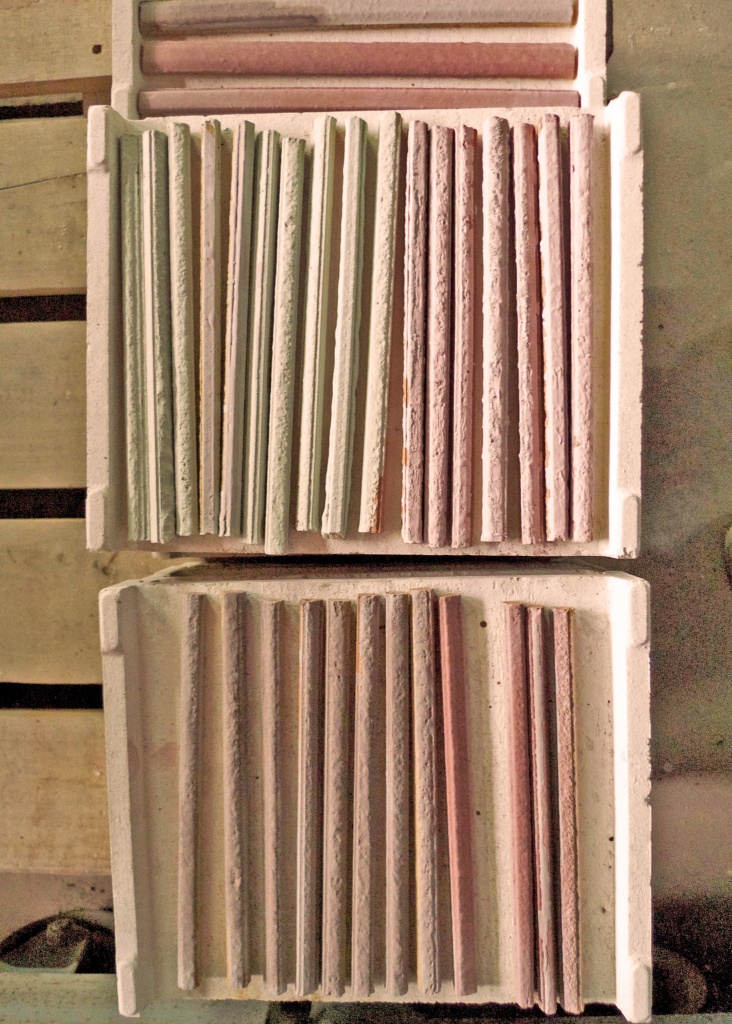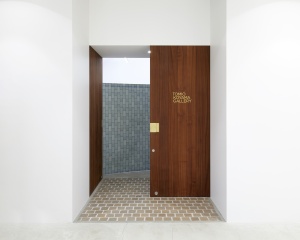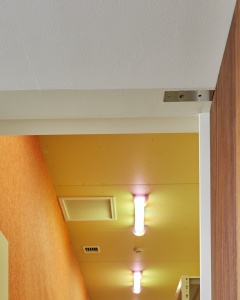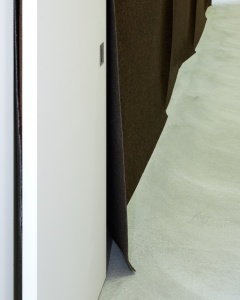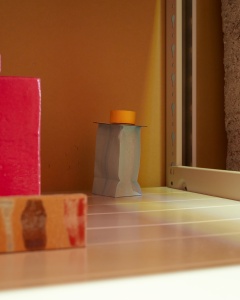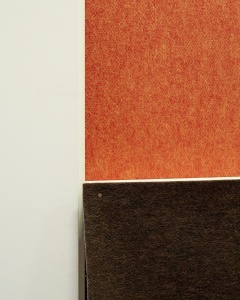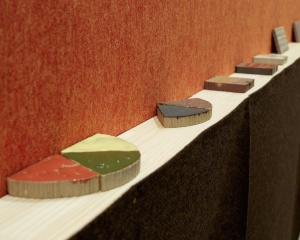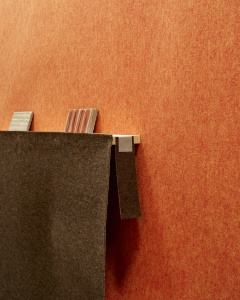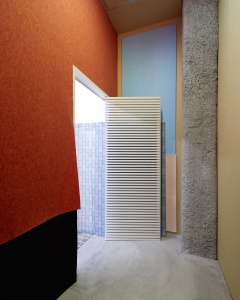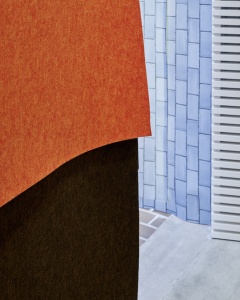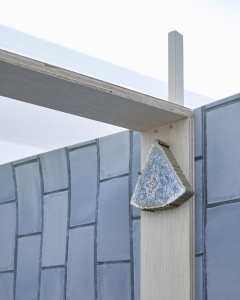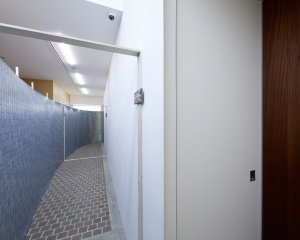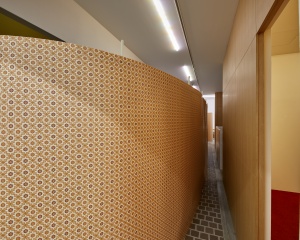In recent years Hiroshi Sugito has held many museum solo exhibitions, and has further continued to widen his platform of presentation. In 2015 he held the solo exhibitions “prime and foundation” at the Miyagi Museum of Art and “frame and refrain” Bernard Buffet Museum in Shizuoka; in 2016, “particles and release” at Toyota Municipal Museum of Art, and this year from July 25th, “module or lacuna” at Tokyo Metropolitan Art Museum. Now more than ever, Sugito has become recognized as one of the most important artists in contemporary Japanese art. This exhibition frontispiece and end leaf is his first in six years at Tomio Koyama Gallery, and will be held concurrently with his solo exhibition ”module and lacuna” at Tokyo Metropolitan Art Museum, with a focus on viewing walls, inspired by terms in bookbinding.
Hiroshi Sugito spent his early years from the age of 4 four to 14 years old in New York. After returning to Japan he was attracted by the delicate lines and beautiful colors of traditional Japanese painting, and studied Japanese Painting at Aichi Prefectural University of the Arts. He started presenting paintings in the field of contemporary art in the 1990s. Moving back and forth between abstraction and figuration, he has depicted geometrical forms including dots, lines, triangles, square and ellipses, and rhythms of fresh and vivid colors on the pictorial plane, and has created unique, illusionistic worlds of painting wherein each motif influences and merges into each other while preserving a descriptive quality.
By the skillful expressions of rich nuances in Sugito’s work, viewers are able to feel even physical sensations such as the senses of touch, light and shade, and temperature, which enter into viewers’ minds and embrace the space. Yoko Nose, curator at Toyota Municipal Museum of Art, remarks on the effects that Sugito’s paintings extend outside the canvas as follows:
A kind of atmosphere that everyone can feel pervades the place, even though all we are looking at are flat, two-dimensional paintings. But the space we are in is not actually empty; there are atoms moving to and fro under the influence of the air and light. On viewing Sugito’s paintings, once begins to feel like a fish in water that has just realized it is wet, and one’s perception of the outside world in changed.
(Yoko Nose, “particles, paintings, raindrops and spaces”, particles and release exhibition catalogue, Toyota Municipal Museum of Art, 2016)
In recent years Sugito has become increasingly interested in architectural spaces and creates “the whole exhibitions as he makes drawings of spaces” (Koichi Wada, “Making Exhibitions According to Space and Painting Are the Evidence of Life”, Bijutsu Techo, July 2015). Although each work has an independent presence, by creating interactions between adjacent works and the spaces around them, composing the space with various materials such as a large lemon-shaped balloon, carpets in light pink or blue, or Styrofoam, and sometimes creating fresh visual effects by reversing the viewers’ exhibition route, Sugito creates multilayered, organic worldviews that can only be experienced in exhibition spaces. Especially for Sugito, the encounter with architect Jun Aoki has led him to new perspectives and possibilities beyond imagination.
Jun Aoki remarks on Sugito’s exhibition:
Starting from that place – the things placed there, paintings on the walls, objects hanging, exterior scenery visible, and then, what you saw and felt when coming there, what you saw when leaving, how you feel at a certain place you’ve never visited or when hearing certain music, and the many memories and incidents – all fall into connection. And with each connection, this world of reality – while remaining just as it is – opens more and more and becomes a world with a different face where the air flows freely in a pleasant way, and goes on changing.
On the other hand, there is also a world within the picture. The picture, being what it is, not only becomes one compositional element of the world opening outwardly; with the same freely flowing air, it opens inwardly into the picture.
Thus, suddenly, this side and that side become seamlessly connected with the picture as an interface.
Which is to say, the world outside the picture is already a picture, and Sugito’s exhibition is our vicarious experience, each in our own way, of a sequence of sensory interactions occurring initially only within Sugito himself.
(Jun Aoki, “Where Does a Picture Begin, Where Does It End?”, particles and release exhibition catalogue, Toyota Municipal Museum of Art, 2016)
Sugito’s work and its worldview remind viewers that the world is not composed of one single direction or perspective, but of many angles, and it keeps continuously changing and re-linking, and is multifaceted. At the same time, his work offers the pure pleasure and joy of viewing paintings, as well as the opportunity to savour a liberation from conventional ways of thinking, in the creation of new powers of the imagination. Sugito continues his explorations of expressing the world perceived and experienced by himself. His experiments in expressions beyond preconceived ideas will be further continued in order to depict the fluidity of the ever-changing world. This is Sugito’s seventh solo exhibition, and his first in 6 years at Tomio Koyama Gallery at its new space in Roppongi, where viewers are invited to witness his new challenges.
—————————————————————————————–
For press inquiries, please contact:
press@tomiokoyamagallery.com (Makiko Okado)
—————————————————————————————–

